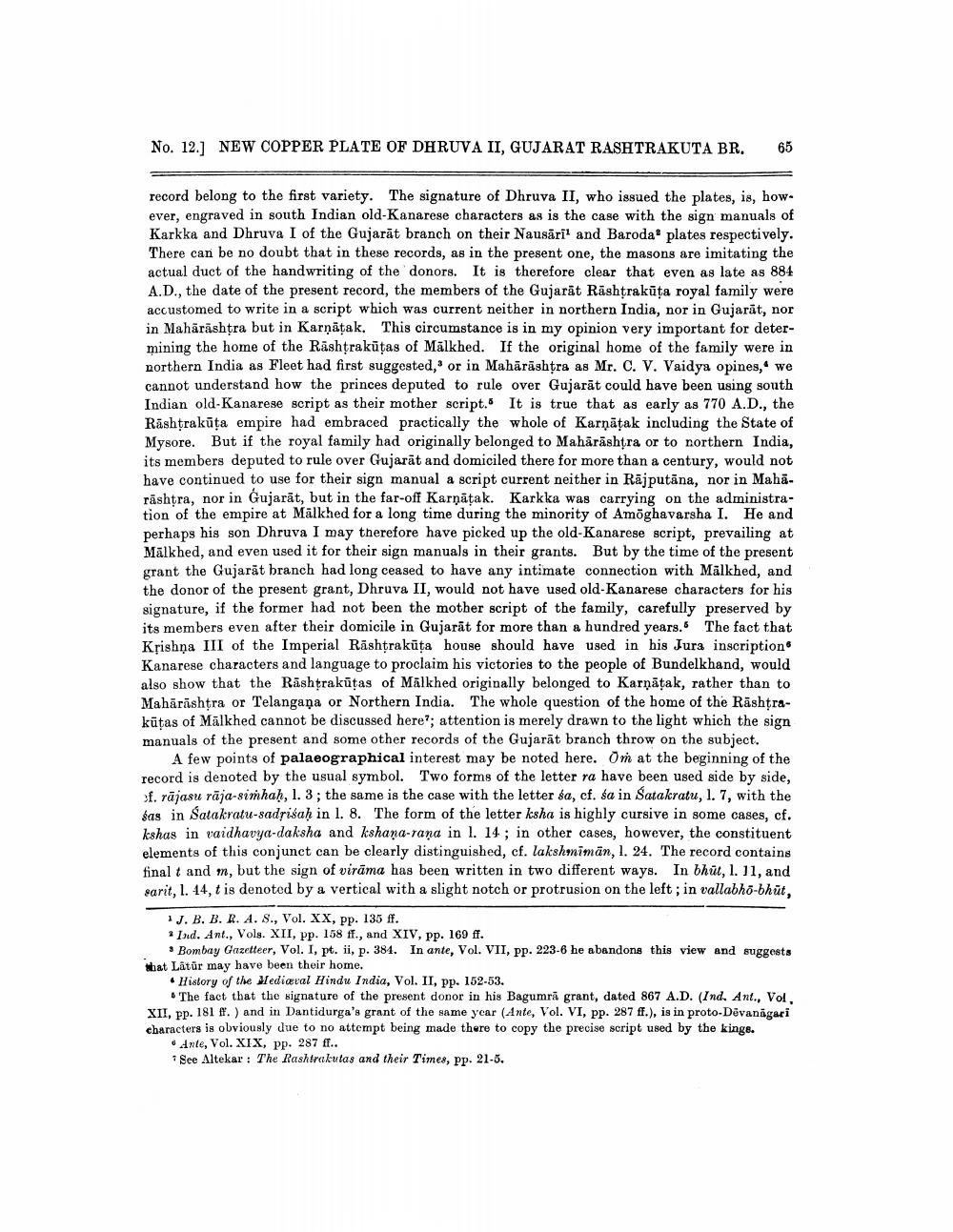________________
No. 12.) NEW COPPER PLATE OF DHRUVA II, GUJARAT RASHTRAKUTA BR.
65
record belong to the first variety. The signature of Dhruva II, who issued the plates, is, however, engraved in south Indian old-Kanarese characters as is the case with the sign manuals of Karkka and Dhruva I of the Gujarāt branch on their Nausāri' and Baroda plates respectively. There can be no doubt that in these records, as in the present one, the masons are imitating the actual duct of the handwriting of the donors. It is therefore clear that even as late as 884 A.D., the date of the present record, the members of the Gujarat Rashtrakūta royal family were accustomed to write in a script which was current neither in northern India, nor in Gujarat, nor in Mahārāshtra but in Karnatak. This circumstance is in my opinion very important for determining the home of the Rāshțrakūtas of Mālkhed. If the original home of the family were in northern India as Fleet had first suggested, or in Mahārāshtra as Mr. C. V. Vaidya opines, we cannot understand how the princes deputed to rule over Gujarāt could have been using south Indian old-Kanarese script as their mother script. It is true that as early as 770 A.D., the Rashtrakūta empire had embraced practically the whole of Karnatak including the State of Mysore. But if the royal family had originally belonged to Mahārāshțra or to northern India, its members deputed to rule over Gujarat and domiciled there for more than a century, would not have continued to use for their sign manual a script current neither in Rājputāna, nor in Mahā. rāshtra, nor in Gujarät, but in the far-off Karņāțak. Karkka was carrying on the administration of the empire at Mālkhed for a long time during the minority of Amõghavarsha I. He and perhaps his son Dhruva I may therefore have picked up the old-Kanarese script, prevailing at Mālkhed, and even used it for their sign manuals in their grants. But by the time of the present grant the Gujarāt branch had long ceased to have any intimate connection with Mālkhed, and the donor of the present grant, Dhruva II, would not have used old-Kanarese characters for his signature, if the former had not been the mother script of the family, carefully preserved by its members even after their domicile in Gujarāt for more than a hundred years. The fact that Krishna III of the Imperial Răshtrakūta house should have used in his Jura inscription Kanarese characters and language to proclaim his victories to the people of Bundelkhand, would also show that the Rāshtrakūtas of Mālkhed originally belonged to Karņāțak, rather than to Mahārāshtra or Telangana or Northern India. The whole question of the home of the Rāshtrakūtas of Mālkhed cannot be discussed here?; attention is merely drawn to the light which the sign manuals of the present and some other records of the Gujarāt branch throw on the subject.
A few points of palaeographical interest may be noted here. Om at the beginning of the record is denoted by the usual symbol. Two forms of the letter ra have been used side by side, f. rājasu rāja-simhah, 1. 3; the same is the case with the letter sa, cf. sa in Satakratu, 1.7, with the fas in Satakratu-sadrisah in l. 8. The form of the letter ksha is highly cursive in some cases, cf. kshas in vaidhavya-daksha and kshana-rana in l. 14; in other cases, however, the constituent elements of this conjunct can be clearly distinguished, cf. lakshmimān, 1. 24. The record contains final t and m, but the sign of virāma has been written in two different ways. In bhūt, 1. 11, and sarit, 1. 44, t is denoted by a vertical with a slight notch or protrusion on the left; in vallabho-bhūt,
1J. B. B. R. A.S., Vol. XX, pp. 135 ff. * Ind. Ant., Vols. XII, pp. 158 ff., and XIV, pp. 169 ff.
* Bombay Gazetteer, Vol. I, pt. ii, p. 384. In ante, Vol. VII, PP. 223-6 he abandons this view and suggests what Lätür may have been their home.
• History of the Medieval Hindu India, Vol. II, pp. 152-53.
• The fact that the signature of the present donor in his Bagumrā grant, dated 867 A.D. (Ind. Ant., Vol XII, pp. 181 ff.) and in Dantidurga's grant of the same year (Ante, Vol. VI, pp. 287 ff.), is in proto-Devanagari characters is obviously due to no attempt being made there to copy the precise script used by the kinge.
Ante, Vol. XIX, PP. 287 ff.. See Altekar : The Rashtrakutas and their Times, pp. 21-5.




